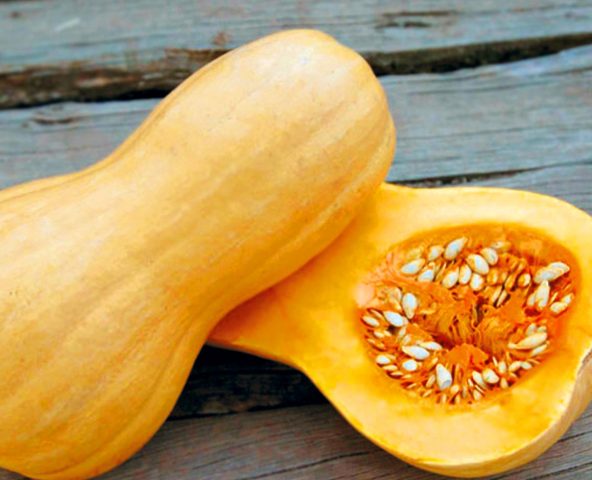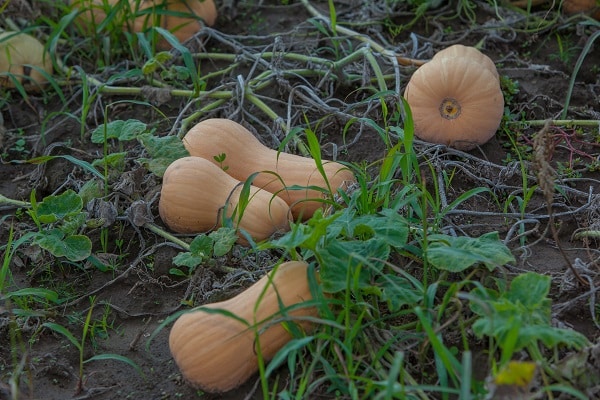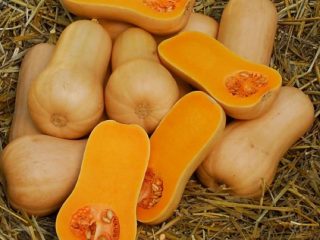Content
Pumpkin Matilda is a variety that belongs to the Dutch selection. It has been included in the Russian State Register of Breeding Achievements since 2009. The crop is recommended for cultivation on private and private farms in the Central Region. Pumpkin Matilda is a medium-ripening table variety. The variety is ideal for making desserts and juices.
Description of Matilda pumpkin
Pumpkin Matilda F1 is an annual, herbaceous plant, belongs to the Muscat type. This is one of the sweetest and most vitamin-rich varieties. The plant is formed climbing. The stems can be up to 5 m long. When several fruits appear on one lash, it is necessary to limit the growth by pinching. Based on the description and photo of the Matilda pumpkin, it is clear that its creeping and powerful stems can withstand the high weight of vegetables. The leaves of the variety are heart-shaped, alternate.
The flowers of the variety are large, but they are not always found by pollinating insects, so manual pollination may be required. To do this, use a brush to transfer pollen from male flowers to female flowers. Male flowers of the culture are distinguished by a longer pedicel.
Description of fruits
The fruits of the variety are large, bottle-shaped, expanding downward. Ribbing is small, more pronounced at the stalk. The skin is thin, easily cut with a knife. The size of one fruit is from 3.5 to 5 kg. The seed chamber is small, located in the wider part of the fruit. The seeds of a plant of the variety may be absent or in small quantities. The rest of the pulp is dense, fleshy, without voids. Average juiciness.
In the photo of the Matilda pumpkin, you can see that the color of the surface, depending on the degree of ripeness, can be from mustard yellow to orange. The pulp of Matilda F1 acquires taste, color and aroma only when fully ripe. In unripe vegetables, it is pale in color, in ripe vegetables, it has a characteristic orange hue. It becomes oily at maturity.
Vegetables remain marketable for 4 months after removal. The taste improves during storage. Pumpkin variety Matilda F1 is highly fortified, with a higher content of carotene than carrots and apricots. The flesh is sweet to taste with a honey aroma. Pumpkin Matilda F1 can be subjected to various types of heat treatment: stewing, baking. And also it is consumed fresh. Used for making pumpkin juices, mixed with apple and carrot juices. Suitable for diet food.
Variety characteristics
Pumpkin Matilda F1 is resistant to high and low temperatures. In the southern regions, the crop is harvested 3 months after germination, in other regions - in early autumn. It is important not to leave the Matilda F1 pumpkin in the open field when even the smallest freezing temperatures come.
The yield of a crop depends on the quality of the soil, the area of planting, the possibility of pollination. Female flowers appear when there is sufficient sunlight. When grown in favorable conditions (on fertile and warm soil), Matilda pumpkin brings about 10 vegetables from one bush. In order for the vegetables to grow larger and have time to ripen, it is necessary to control the growth of the lashes. The crop is suitable for industrial cultivation. The yield of Matilda pumpkin per hectare is 696-940 centners.
Pest and disease resistance
Pumpkin variety Matilda F1 is resistant to various infections and pests.But under unfavorable growing conditions, a small number of sunny days, various fungal diseases can affect the culture. At the same time, during the dry period, a spider mite may appear on the leaves.
For dense plantings with a large amount weeds the vegetative mass is affected by the melon aphid. To prevent the appearance of pests, it is necessary to observe the crop rotation of crops and not to grow Matilda F1 pumpkin in one place more than 1 time in 3-4 years.
Advantages and disadvantages
The Matilda hybrid is plastic, which means it is highly adaptable to the environment and growing methods. The Dutch breeding culture is well adapted to the Russian climate. Resistant to stressful weather conditions. Has a stable yield. The positive quality of the variety also includes its low susceptibility to diseases.
The main advantages of the Matilda F1 fruit are a large amount of pulp, high yield. The vegetables have an excellent internal structure and commercial quality. The fruits are of high nutritional and vitamin value. Contains a large amount of sugar and mineral salts. Cleanses the body of toxins.
Pumpkin Matilda F1 requires a large planting area. Pumpkins can be picked unripe and grown indoors. Vegetables have good keeping properties. Stored up to 4 months. Matilda F1 is suitable for transportation.
The disadvantages include the fact that the hybrid, denoted by the F1 mark, does not involve growing from its own seeds. Resistant signs of the Matilda F1 pumpkin variety shows only when planted from seeds that can be found on the market. Such planting material is obtained through complex breeding work, which cannot be done at home.
Growing pumpkin Matilda F1
The culture requires high temperatures for germination. In the first days of growth, the taste of the fruit is laid. Therefore, depending on the region of cultivation, it is planted in a seedling and non-seedling way.
Planting seeds of the variety for seedlings begins from the end of March and continues until mid-April. It will take about 30-35 days to grow seedlings. Young plants do not tolerate transplanting well. Therefore, it is most favorable to plant seeds in peat tablets. These planting containers contain all the necessary substances for the initial stage of growth. In open ground, seedlings grown in peat tablets are transferred without removing the shell from the earthen coma.
Only sunny areas are suitable for growing. When planting a pumpkin, varieties Matilda F1, by direct sowing in open ground, you must wait until a constant air temperature is set from + 16 ° C. For cultivation, tall, warm, nutrient-rich beds are built or compost heaps are used.
The soil in the place where the melons are grown is prepared in the previous season. Top dressing is applied when digging up the soil in the fall. The seeding depth is 6-8 cm. For the growth of the culture, a sufficient area of nutrition and illumination is required. Therefore, the distance between plants must be kept about 1 m.
For melons, regular watering is required. Before the fruit appears, it is watered once every 5 days, using about 3 liters of water per plant. In the fruiting phase, watering is increased up to 1 time in 3-4 days. For irrigation, use warm water, pouring it not under the root, but over the soil in the circumference of the leaf part.
The growth of the lash must be limited so that the vegetables can gain mass and maturity. To do this, pinch the main stem when 2-3 fruits appear on it. On the side lashes, one fetus is left. Leaves are left in an amount of 4-6 pcs. for one fruit. The rest are removed so as to open the access of light to the fruits.
Complex mineral fertilizers are used for feeding. When a young plant is first fertilized, the dosage is reduced by 2 times. Organic fertilizers are also used:
- manure;
- bird droppings;
- humus;
- biohumus;
- ash;
- herbal infusions.
To achieve the best result when growing pumpkin, mineral and organic fertilizers should be alternated depending on the initial nutrient content of the soil. When growing melons, it is important to apply fertilizers evenly and regularly.
Harvesting is carried out before frost, the pumpkin can be covered in the soil if the temperature is expected to drop. Vegetables are laid for storage without damage, the length of the stalk is left about 8 cm.
Conclusion
Pumpkin Matilda F1 is a culture created with improved growth qualities, has a quick ripening period, excellent taste characteristics. Does not lose marketability during long-term storage. In the description of the variety, Matilda pumpkin is indicated as unpretentious in care, resistant to weather changes and high-yielding culture.











